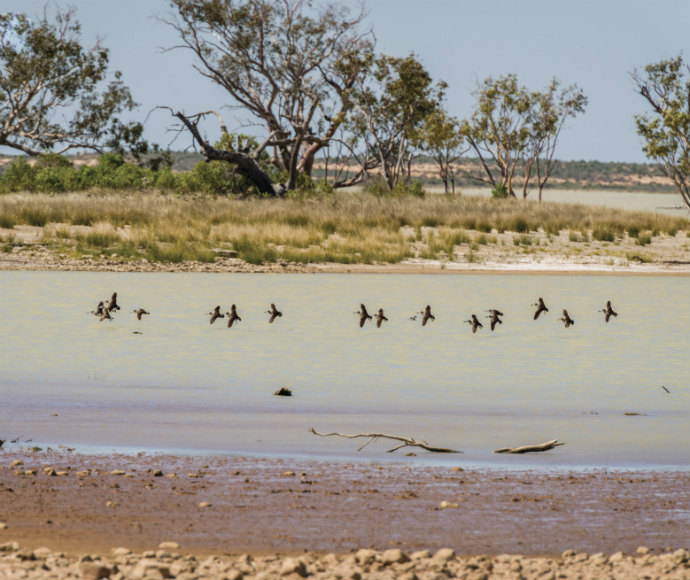The Paroo River is in far western New South Wales. It is considered the last free-flowing river in the Murray–Darling Basin. The Ramsar site consists of 2 parts:
- Nocoleche Nature Reserve (71,133 hectares), near Wanaaring
- the Peery Lake section of Paroo–Darling National Park (67,171 hectares), near White Cliffs.
The site includes large overflow lakes, tree-lined creeks and waterholes, lignum and canegrass swamps, and artesian mound springs.
Why these wetlands were listed as a Ramsar site
Countries that sign up to the Ramsar Convention can nominate sites to be listed as Wetlands of International Importance (Ramsar sites). The site must meet at least one of 9 internationally accepted criteria.
The Paroo River Wetlands were listed as a Ramsar site in 2007 because they meet the following criteria.
Criterion 1: Representative or unique wetlands
The Paroo River is a unique example of a near-natural, arid inland wetland system in the Murray–Darling Basin. An arid inland wetland is one that is mostly dry but fills every 6 to 7 years, mainly from rainfall.
It maintains a natural pattern of water flow because there are no major diversions, dams or weirs.
It also has 2 distinct sets of artesian mound springs, which are characterised by either deposits of sediment and salt or depressions. They are some of the rarest landforms in Australia.
Criterion 2: Threatened species or ecological communities
Several threatened plants have been identified in the Paroo River Wetlands, including the salt pipewort, considered the rarest vascular plant in New South Wales. The vegetation adapted to the artesian mound springs is also listed as a threatened ecological community.
Criterion 3: Populations of plants and/or animals important for maintaining biodiversity of a particular bioregion
The Paroo River Wetlands are recognised as a significant refuge for biological diversity because they contain unique genetic, species and ecosystem diversity.
There are newly identified plant and crustacean species, and a separate breeding population of golden perch.
There is also a high diversity of bird populations. The wetlands of the Paroo and Warrego rivers are some of the most important areas for waterbirds in the Murray–Darling Basin.
The wetlands within Nocoleche Nature Reserve support one of the largest stands of yapunyah, a medium-sized floodplain tree restricted to the Paroo region in New South Wales. It has a high tolerance for drought and extremes of temperature.
Criterion 4: Supports species at a critical stage of their life cycle or provides refuge in adverse conditions
The Paroo River Wetlands constitute a key drought refuge in arid New South Wales. They play an important role in waterbird breeding, with 11 species of waterbirds recorded breeding at Peery Lake and 38 species at Nocoleche Nature Reserve.
The maintenance of species diversity relies on the assortment of habitats provided along the Paroo, including pools, floodplains, swamps and marshes, and semi-permanent lakes.
Criterion 5: Supports 20,000 or more waterbirds
These wetlands are of outstanding importance for waterbirds, regularly supporting more than 20,000. The highest numbers were in 1993, when 35,900 waterbirds were recorded at Peery Lake and 28,000 at Poloko Lake, part of which falls within the Ramsar site.
Criterion 7: Supports a significant proportion of indigenous fish species or families representative of wetland benefits or values
The Paroo River Wetlands support one of the healthiest native fish communities in the Murray–Darling Basin. Recent research has found the site’s golden perch population is genetically distinct and effectively a separate breeding population from golden perch elsewhere in the basin.
How the site is managed
Management of this Ramsar site is guided by the following:
- the site’s Ramsar information sheet
- its ecological character description
- plans of management for Nocoleche Nature Reserve and Paroo–Darling National Park.
The site’s significance for Aboriginal people
The Paakantji and Budjiti people are the traditional owners of the Paroo. They were involved in the Ramsar site listing and continue to be consulted on how the reserves are managed, for the following reasons:
- Nocoleche has significance for both groups for trade, as a living place, workplace and for food, water and stories.
- Peery Lake is significant to the Paakantji people.
- The Paroo country has natural, cultural and spiritual significance for both groups. The river is ‘the lifeblood of the community’.
Threats to the Ramsar site
The main threats to this site’s ecological character include:
- introduced plants and animals, particularly pigs and goats, which have impacts on the artesian mound springs vegetation
- climate change
- visitor impacts.
